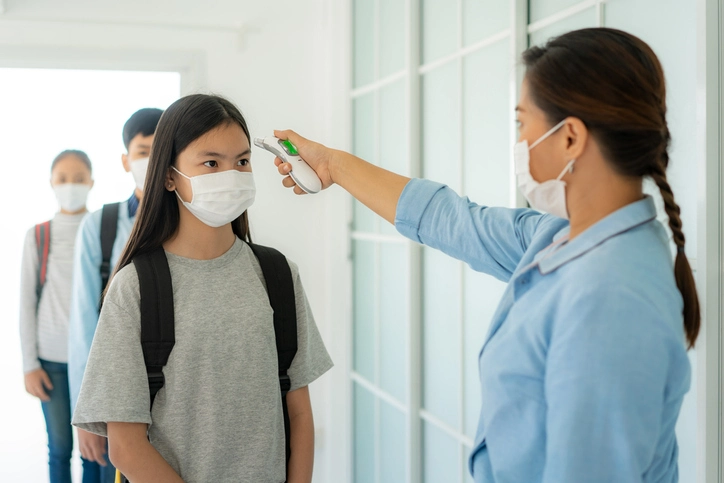The start of the school year heralds a return to education but also marks the onset of various back-to-school sicknessesthat families with children will have to navigate. In this article, we’ll equip parents, caregivers, and educators with valuable insights into navigating the realm of back-to-school sicknesses. From understanding the reasons behind these ailments to practical strategies for prevention and management, we’ve got you covered.

Why Do Kids Get Sick When Going Back to School?
The return to school lays the perfect foundation for germs to thrive and spread. The reasons behind these illnesses are multifaceted and can include:
Exposure to Germs
The close quarters of classrooms, playgrounds, and shared spaces create an environment conducive to germ transmission. Viruses and bacteria spread through direct contact and contaminated classroom surfaces.
Weakened Immune Systems
Breaks from the school routine lead to decreased germ exposure, which can temporarily weaken immune systems. Returning to school requires these immune systems to adapt to the increased exposure.
New Strains of Germs
The mingling of children from diverse backgrounds introduces new strains of viruses and bacteria that immune systems may not have encountered before.
Hygiene Practices
Children’s hygiene habits are not always optimal. Inadequate handwashing, improper cough etiquette, and close contact with sick peers contribute to the spread of illnesses.
Close Contact
Shared items and physical interactions are part and parcel of the school experience, creating ample opportunities for infections to spread.
Incomplete Vaccination
Not all children are fully vaccinated against preventable diseases, leaving some more vulnerable to infections circulating within schools.
Stress and Fatigue
The transition back to school, with its new schedules and expectations, can induce stress and fatigue, which, in turn, may suppress the immune system’s defenses.
Seasonal Changes
The back-to-school period often coincides with shifts in weather, leading to increased respiratory illnesses like colds and flu.

Common Back-to-School Sicknesses
The spectrum of illnesses that accompany the back-to-school season is wide-ranging! Here are some of the most common back-to-school maladies and their symptoms:
Common Cold
The close interactions in schools foster easy transmission of cold viruses. Symptoms include a runny or stuffy nose, sneezing, coughing, and a mild fever.
Flu (Influenza)
The flu’s contagious nature makes schools an ideal breeding ground. Symptoms can include fever, chills, body aches, fatigue, cough, and sore throat.
Stomach Flu (Gastroenteritis)
Viral or bacterial infections can lead to nausea, vomiting, diarrhea, abdominal pain, and fever. Hygiene practices play a pivotal role in prevention.
Strep Throat
Streptococcus bacteria causes sore throat, fever, and difficulty swallowing. It spreads via respiratory droplets and requires medical attention.
Hand, Foot, and Mouth Disease (Coxsackie Viral Infection)
Common among young children, this viral infection brings fever, mouth sores, and a rash on the hands and feet through direct contact.
Pink Eye (Conjunctivitis)
Easily transmissible through shared objects, this eye infection presents with redness, itching, discharge, and crusting.
Head Lice
Close head-to-head contact facilitates the spread of these parasitic insects, leading to itching and discomfort and necessitating that your child stay home.
Respiratory Infections
Beyond cold and flu, respiratory infections like bronchitis and pneumonia are common due to increased germ exposure.
Viral Rashes
Various viruses cause rashes, often accompanied by mild fever and discomfort.

When to Seek Medical Attention for Your Child
Determining when medical attention is necessary requires careful consideration. Here are symptoms to look out for that might mean your child needs professional medical attention:
High Fever
A persistent high fever, unresponsive to over-the-counter medication, warrants consultation with a doctor.
Difficulty Breathing
Labored breathing, wheezing, or bluish skin demands immediate medical attention.
Dehydration
Symptoms like dry mouth, reduced urine output, and lethargy indicate dehydration, necessitating medical consultation.
Severe Vomiting and/or Diarrhea
Excessive vomiting or persistent severe diarrhea, especially with blood, calls for medical intervention.
Severe Pain
Unrelenting, severe pain, particularly abdominal or head pain, requires medical assessment.
Rashes and Behavioral Changes
Rashes with discomfort and unusual behavior changes, like confusion or lethargy, necessitate medical attention.
Respiratory Issues
Persistent, worsening cough or difficulty breathing requires medical evaluation, especially in children with respiratory conditions.
Get Help From Austin Emergency Center
When your child is sick, expert care is vital. As back-to-school sickness emerges, Austin Emergency Center stands as a reliable partner in quality pediatric care. Equipped with a skilled healthcare team, modern facilities, and a family-friendly environment, we understand the challenges these illnesses bring.
Whether it’s a stubborn fever or a persistent cough, we offer swift, compassionate care for your child. With minimal wait times, we ensure your child receives timely attention, enabling a swift return to learning and play.

